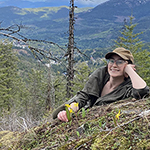Deadline extended to Aug 5!

Need a little more time? This is your chance to submit your personal essay, memoir, narrative nonfiction, social commentary, travel writing, historical account, biography, and more! Extended deadline is August 5, 2021 at 11:59pm PDT. One winner will take home the $1000 (CAD) prize, and the winning piece will be published in our winter issue.
Entry fee (comes with a one-year print subscription):
$35 CAD for Canadian entries
$40 USD for entries from the USA
$45 USD for entries from elsewhere
Additional entries cost $15 CAD each, no limit!
This year's judge is Emily Riddle. Read an interview with her to find out what she's looking for in a winning entry.
Full contest guidelines on our website.
summer issue interview with Sean Sam on cnf
 Malahat Review Fiction Board member Danielle Geller talks with the summer issue #215 contributor about varying his tone and style, letting content alter form and vice versa, and how part of writing comes from the way we experience time. Malahat Review Fiction Board member Danielle Geller talks with the summer issue #215 contributor about varying his tone and style, letting content alter form and vice versa, and how part of writing comes from the way we experience time.
DG: Part-way through “Figure Balancing Over Rushing Water,” there is a shift in perspective, one you describe as a kind of out-of-body experience. The narrative eye, the “I,” describes himself as if from above. The way the essay closes also plays with perspective and point of view: “See the boy on the ladder…. He must be careful.” Could you speak a little about narrative time and distance? About memory?
SS: I can’t say why people write or make art, but I think part of it comes from the way we experience time, and, by extension, how we access our memories. Time is a substrate we see through.
For a dog, memory and time are like a circle, a field to constantly explore. For us, time is like an arrow or a line. We can float over this arrow in our minds, landing here or there when we remember someone. From an early age, we can see the end. When I write nonfiction, I’m trying to solidify something along that line, a feeling or impression, letting other people experience it too.
Once you choose the details to enhance, what to leave in or leave out, modern creative nonfiction is almost as artificial as fiction, constrained only by the truth. So, my original memory was written over, still reflective of the bare facts, but now a palimpsest for a different point of view. I hope this sudden shift helped the piece remain close to an issue in most of my writing—consciousness as an eerie container.
Read the rest of Sean Sam's interview.
summer issue interview with Carlee Bouillon on fiction
 Malahat Review Creative Nonfiction Board intern Anne Hung talks with the summer issue #215 contributor about stories as memory devices, writing from the perspective of a young narrator, and how every fiction is somebody’s documentary. Malahat Review Creative Nonfiction Board intern Anne Hung talks with the summer issue #215 contributor about stories as memory devices, writing from the perspective of a young narrator, and how every fiction is somebody’s documentary.
AH: Told from an eleven-year-old girl’s point of view, “You Should Be There (When They Go)” grapples with mental illness, trauma, death, and compassion. What inspired you to explore these complex topics through such a young narrator?
CB: My original plan for this story was relatively lighthearted. I wanted to write a story about a kid with a horse, because when I was a kid, I had a horse, and it was a neat time. I loved him (good old Hudson) with my whole, tumultuous pre-teen heart, and to this day I think that has been the simplest, most unselfish transaction of love I have experienced. So, I figured writing about a horse based on Hudson (the quirky and bumbling packhorse of my childhood) would be a fun exercise—an opportunity to try writing about love. I actually thought it would be a reprieve from writing more intense adult content. In hindsight, that was pretty dumb. I’ve been eleven—I should have known that going back into the brain of an eleven-year-old would be weird and sad and confusing. When I got into this narrator’s head, it came back to me just how obliterating my feelings used to be at her age. The good, bad, ugly—it makes no difference, all of them were intense. It’s the part-blessing, part-curse that afflicts every kid: the need to feel everything to the extreme because life hasn’t taught you to put up guards yet.
I wanted “You Should Be There (When They Go)” to reveal a small window of this narrator’s life, unfiltered by adult perception. And I wanted this window to be complete—difficult elements not exempt. I never set out to write a story about trauma, death, or mental illness. Even after its development, I don’t define this story, in my head, to be “about” trauma, death, or mental illness. Those elements appeared partway through development, after my narrator came to life, and I hardly feel like I made them up—it seemed rather like they were just the things she was dealing with at the moment I decided to portray her. I don’t mean that they are in the story without intention—absolutely each element in this story has been interrogated for its purpose—I just mean that these topics are not exclusively adult problems, and it became important to me that if I am going to reveal a piece of a child’s life, I recognize that hard things are just as likely to be there as they would in an adult’s life (and appropriately acknowledge them). This is when I developed the rest of her world. I became interested in this concept of a young narrator as an ill-informed documentarian. She doesn’t quite grasp the story she’s telling, because she hasn’t been exposed to trauma and death and mental illness before. But she still has to be the one to respond to her experiences, with little background knowledge. Then it becomes up to the reader to pick up the pieces of her narrative and put them together. That was such a counterintuitive way for me to write. It’s natural to create narrators who know more than the reader, not the other way around.
Read the rest of Carlee Bouillon's interview.
|